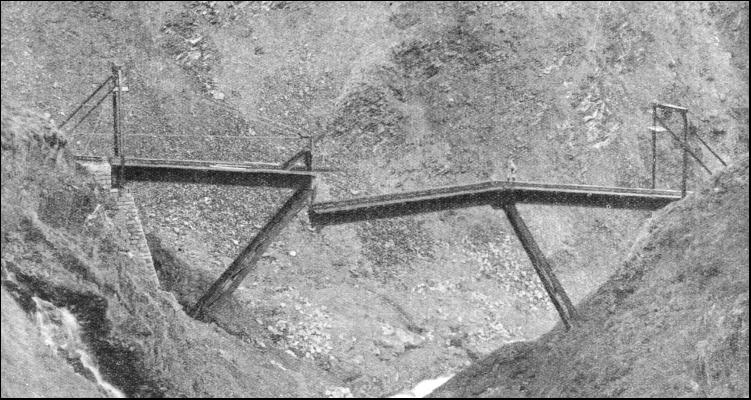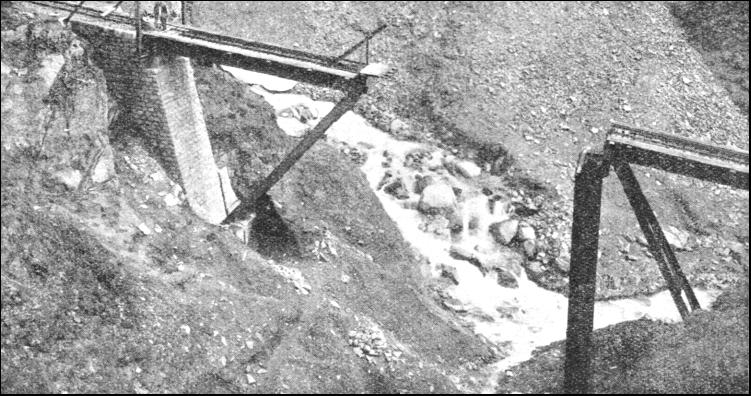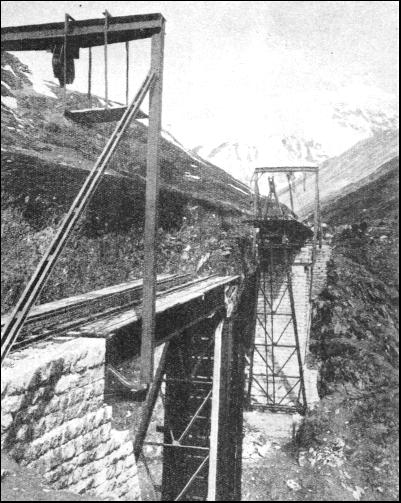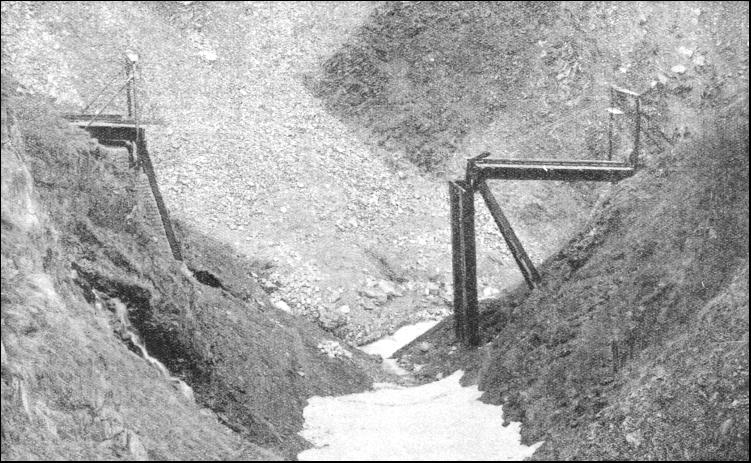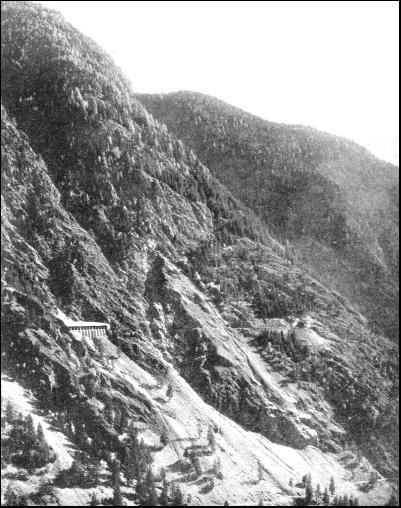|
|
SNOW is one of the most serious obstacles that the railway engineer must overcome. One of the countries chiefly affected is Switzerland, where a large proportion of the surface area is situated above the permanent snow-line, at levels where snow and ice are to be found throughout the year. In other parts of the country, in midwinter, even where the height above sea-level is not more than two thousand to three thousand feet, snow may fall to a depth of several feet in exceptionally cold seasons. But it is not the mere depth of snow-fall that raises apprehensions. So far as the railways are concerned, snow deposited on the tracks is no more than obstruction, and though snowdrifts hamper railway operation, they can be cleared by means of rotary ploughs, which make a path through the snow for the trains. On high-lying railway routes like the Bernina, rotary ploughs have cut their way through drifts as deep as 18 ft. But if snow accumulates to a depth of 18 ft. on the summit of the Bernina Pass, which is at some 7,630 ft. above sea-level, it can well be imagined that the depths of deposit on the higher mountains are greater. And it is in these masses of snow, often insecurely held on steep (or nearly perpendicular) mountain-sides, that the chief dangers lie. Something quite trivial, like a sudden gust of wind, will cause one of these masses of snow to break loose. The danger is the greatest in the spring and early summer, when the melting of the snows has begun, and the foundations of these deposits become undermined. Deprived of support, the mass of snow starts to slide rapidly downwards. Fortunately many avalanches spend their force high up in the mountains. Others follow the regular avalanche tracks—which the traveller in Switzerland can easily recognize by the deep furrows that the avalanches have scored in the mountain-side. If an avalanche keeps to a track there is little danger of its striking anything on its way down. But sometimes an avalanche will sweep down by other and unexpected paths. It grows larger and larger and more terrifying as it gathers speed. Nothing is safe from it, and on several occasions entire villages have been destroyed by this dreaded menace of the Swiss mountains. On the Rhaetian Railway of Switzerland a serious accident once occurred, between Davos and Klosters, near a village called Wolfgang, when an avalanche came down suddenly from the neighbouring mountains and derailed a passing train.
A similar accident occurred a few winters ago on the small railway that connects Visp, in the Rhône Valley, with Zermatt, the popular mountain resort of south-west Switzerland. Without warning, an immense avalanche shot down from the mountains on the west side of the valley, between Ronda and Zermatt, sweeping away the overhead electric equipment and completely burying the line. For a time, Zermatt was cut off from all communication, and the mass of the avalanche was far too great to permit of the line being dug out from above. But the Swiss are a resourceful people. Without any loss of time they excavated a tunnel through the avalanche, lined it with timber, and ran their trains up to Zermatt under the snow and ice until the spring sun came. Since then the railway has been diverted and securely roofed-ln at this danger-spot, and no longer need the power of the avalanche be feared between Randa and Zermatt. Generally speaking, avalanche dangers are greater at the higher altitudes. The site of the avalanche destruction between Randa and Zermatt is roughly five thousand feet above the sea ; where the train was derailed on the Davos line the track is higher still.
The perils are the greatest when a railway is carried on a shelf that has been blasted out on some almost perpendicular mountain-side, of which so many examples can be found in Alpine and similar regions. Here permanent protection for the line is vital. Something more substantial is needed than the timber snow-sheds of earlier days, designed more to shield the lines from snowdrifts than to guard them from the destructive attentions of avalanches. For it is on these steep slopes that the avalanches are travelling at their maximum speed, and so exert the greatest force. On such a line as the Lötschberg Railway in Switzerland, therefore, where it passes down the four miles of the Lonza Valley between Goppenstein and Hothen, high up on the east side of this V-shaped gorge, many avalanche tunnels may be seen. For the most part, these structures are of concrete, built on a massive scale. The top of the avalanche tunnel is sloped towards the valley, and the effect, when the avalanche gets down to the level of the line, is that it drops on to the sloping roof of this shelter, and is shot harmlessly into the valley below. At every point where the Lötschberg Railway crosses one of these recognized avalanche tracks, the line has been securely roofed over in this way, and all avalanche perils are thus averted.
But the avalanche protection is not confined only to the immediate vicinity of the line. If the passenger over the Lötschberg were to climb some of those formidable slopes above the line, in the Lonza Valley, he would find what might appear to him to be the remains of early Swiss fortifications, resembling isolated sections of the Great Wall of China. All these short masonry walls are related to the railway below. They have been erected at strategic points all over the mountain-side. In their irregular battalions, like a whole series of breakwaters, they check the force of the masses of sliding snow before they get down to the level of the railway. Shortly after the war the Furka-Oberalp Railway was opened to connect the valley of the Rhône with that of the Rhine, along the great central cleft of Switzerland which is so prominent a feature of any contour map of that country. Its name is taken from the two high passes, the Furka and the Oberalp—over which it passes on its journey from Brigue, at the mouth of the Simplon Tunnel, through Andermatt to Disentis, in the Canton of the Grisons. The former of these passes, at the level of the tunnel which pierces its crest, is 7,100 ft. above the sea-level, and the latter is 6,720 ft. As the traffic carried by this line is, for the most part, only summer tourists, the expense of protecting the line from drifts and keeping it clear from snow throughout the winter would not be justified. Thus, except for traffic up the valleys at the two extreme ends of the line, and for trains run for ski and toboggan enthusiasts from Andermatt up to the Oberalp Pass during the winter-sport season, the Furka-Oberalp Railway is closed to traffic. After an emergence from the Furka Tunnel at the east end, the railway comes out into the upper end of the Reuss Valley, and has not proceeded more than half a mile when it has to cross a lateral gorge, down which there flows the Steffenbach, a tributary of the Reuss. Owing to the configuration of the mountains above, the Steffenbach ravine is a notorious centre for avalanches throughout the early part of the year. Massive, swift, and destructive avalanches they are, too ; so much so that in the spring after the Furka-Oberalp Railway had first been opened, the bridge carrying it over the Steffenbach gorge was swept completely away. A new and a stronger structure was then erected ; but Nature playfully repeated her tricks in the following spring, and once again the Steffenbach gorge was without a bridge. It was distinctly tiring to have to put up a new bridge every summer, and the engineers of the line determined to get the upper hand. The Steffenbach's necessity proved the mother of invention, and the Furka-Oberalp engineers designed a unique bridge which takes to pieces and packs away for the winter. They can now view all the vigorous activities of Nature at this particular location with the utmost unconcern. The bridge lies at a considerably higher altitude than any of the lines previously mentioned, and at a very inaccessible spot.
The photographs illustrating this page show quite clearly the method of construction and of dismantling. The bridge consists of three spans, supported on masonry piers at each end, and in the centre by two diagonal steel trestles, which normally incline upwards from the base of the masonry piles, at an angle of about 45 degrees. At the ends of each of these trestles or struts are hinges, which play an important part in the work of dismantling and reassembly. The middle girder span of the bridge is also independent of the two side spans ; at one end it is bolted to the adjacent side span, and at the other end it is carried on a hinge. At each end of the bridge there may be seen above the track a steel arch, carrying the permanent tackle which is used in the dismantling operations. In the first of the photographs dismantling has just begun. The centre span has been unbolted at the left-hand end, and is being lowered down on its hinge at the right-hand end, until it is finally hanging vertically, as may be seen in the second illustration. It will be noticed in these pictures that the track is provided, in the centre, with the steel rack used in mountain railway working, for this is on a steep section of the Furka-Oberalp Railway, up to the Furka Pass, worked by rack-and-pinion gear. Next comes the operation which is seen the most clearly in the end-on, or third view of the bridge. At the shore end, one of the side girders has been hoisted off the bedstones on which it was resting, and lifted up, until it has cleared the railway track at the side of the gorge. It has then been drawn backwards, with its supporting trestle swinging round on its hinges, until the latter, having swung round nearly 90 degrees, comes flat up against the masonry of the abutment. The side span is then dropped down to rest on the rails of the track, which are now below the whole of its length, and the operation on that side of the bridge is complete, as the fourth illustration shows. The side span on the opposite side of the bridge is then tackled in the same way. But as its supporting trestle swings round on its hinges, it brings with it also the centre span of the bridge. This swings on the hinge by which it is pivoted to this side span, so that when this trestle comes up flat against its abutment, it has the centre span resting snugly against it. In this way the Steffenbach gorge is completely freed and the avalanches can come down and do their worst without giving the engineers a moment's concern. In the late spring the engineers return, and a short spell of work is sufficient to draw the various sections of the bridge from their winter resting-places, to bolt them together, and so to prepare them once again to carry the trains. Fortunately the locomotives and rolling stock in use on the Furka-Oberalp Railway, which is of metre gauge, are fairly light in weight, for the difficulties of designing a bridge of this description would have been intensified had it needed to carry full-size main line locomotives.
Many thanks for your help
|
   Share this page on Facebook - Share  [email protected] |

